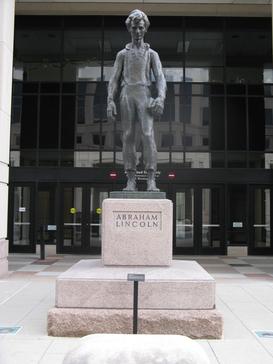Background information
In his visits to Indianapolis, Wilson found that there was only one, unnamed African American represented in the city's many memorials and sculptures. [7] The formerly enslaved African American figure appears at the base of the Indiana Soldiers' and Sailors' Monument, a 284 ft. 6 in. commemoration of the American Civil War, the American Revolution, the War of 1812, the Spanish–American War and the Mexican–American War. Some suggest that with the passage of time the commemorative nature of war memorials has been replaced with a more utilitarian purpose, such as city beautification. [11] Consequently, the Soldiers' and Sailors' Monument is said to symbolize both the city of Indianapolis and the state of Indiana. [12] While others argue that there is nothing more invisible than monuments, [13] some art historians suggest that art can be utilized as a vehicle for racist ideology. [14]
Wilson is known for his practice of "mining the museum" for objects that he can recontextualize in order to question issues of representation and narrative voice. [15] He spent time in Indianapolis in 1993 when he created a show for the Indianapolis Museum of Art titled "The Spiral of Art History." It was at this time that he noticed the abundance of monuments in Indianapolis, which would later inspire his vision for E Pluribus Unum. This is the first time that Wilson has "mined" a city's monuments in order to create a public artwork. [7]
Peace group

The original figure of E Pluribus Unum, a formerly enslaved African American man, is part of a 250-ton sculpture known as the Peace group, which was designed by Herman Matzen and carved by German sculptor Rudolph Schwarz from fifty five separate blocks of limestone. In the center of the Peace group, a female figure known as both "Liberty" and "Angel of Peace" holds a Union shield and a flag wrapped in an olive branch. On the shield are the words E pluribus unum, which offers the sculpture its namesake. For Wilson, however, the phrase references Africa and the Black Diaspora. She is flanked by a blacksmith sitting on an anvil, who represents industry; a sheaf of wheat, which represents agriculture; and a homecoming of soldiers, whose lack of headgear symbolically illustrates the end of the war. [11] At her feet sits the freed African American male figure, whose positioning reflects a common trope in nineteenth-century American sculpture that depicts African Americans kneeling in gratitude while holding broken manacles or discarded whips. [14] These post-Reconstruction era of the United States depictions of formerly enslaved people, often shown with uncertain, upward gazes aimed toward their liberators, minimized African American efforts and sacrifices in obtaining freedom and instead interpreted the Emancipation Proclamation as an act of white benevolence. [14]
Indianapolis Cultural Trail
E Pluribus Unum was commissioned by the Central Indiana Community Foundation (CICF) to be included on the Indianapolis Cultural Trail: A Legacy of Gene & Marilyn Glick. The Cultural Trail, a $63 million project, [6] is an urban pedestrian and bike path connecting the city's five cultural districts: Indiana Avenue, Massachusetts Avenue, Fountain Square, the Wholesale District and the Canal and White River State Park. [16] A total of $2 million has been invested for new public artwork along these cultural districts in Indianapolis. [17] The curatorial advisory committee for the Cultural Trail is composed of representatives from the Indianapolis Museum of Art, Herron School of Art and Design at Indiana University–Purdue University Indianapolis, Eiteljorg Museum of American Indians and Western Art, Indiana State Museum, and other cultural organizations in city. [18]











